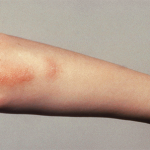The review covers several opportunities for diagnosing and monitoring MAS. Of those introduced in the case study, CXCL9 is a chemokine released in response to, and a reliable measure of, interferon-gamma (IFNγ) activity. IL-18 is a pro-inflammatory cytokine often elevated during inactive Still’s disease, more so during MAS. Meanwhile, levels of soluble CD25, which is shed by activated T cells, rise in MAS, but also with infectious, autoimmune and neoplastic conditions.
“Marked elevation of CD38+HLA-DR+ cycling lymphocytes is readily identified by flow cytometry and represents a hallmark of MAS,” Dr. Nigrovic writes. “Typically, the laboratory abnormalities of MAS emerge together, such that elevation in one value in the absence of others should trigger consideration of other entities.”
Treatment for MAS is reviewed in the 2022 ACR/EULAR consensus report.3 Key agents in routine use include glucocorticoids and anakinra, both discussed in the case study; Janus kinase inhibitors, such as ruxolitinib; calcineurin inhibitors tacrolimus and cyclosporine; monoclonal antibody emapalumab, which neutralizes IFNγ; and topoisomerase II inhibitor etoposide.
The review includes a figure depicting an algorithm for treating MAS in suspected Still’s disease and a table detailing drug dosing and monitoring.
“Treatment of MAS is not standardized. Intensity of therapy is generally proportionate to illness severity,” Dr. Nigrovic explains. “It is important for the clinician not to be reassured if the patient appears relatively well, or to mistake ‘normal’ platelet count or falling ESR as evidence of improvement. Primary HLH is typically managed by hematology/oncology specialists using etoposide, but this agent is generally not indicated for MAS related to Still’s disease unless other options have failed.”
Final Thoughts
Dr. Nigrovic, who practices both pediatric and adult rheumatology, notes, “Here at Boston Children’s Hospital and at the Brigham and Women’s Hospital, we’ve had a surprising number of difficult MAS cases over the last few years that have posed real challenges for our inpatient teams. My goal for this review was to provide a guide to our adult and pediatric rheumatology fellows and attendings as they handle these very sick patients.
“I was fortunate to have many of our fellows volunteer to read the draft to ensure that it provides a clear path forward for them. I am especially grateful to my many expert colleagues, locally, nationally and internationally, who provided comments on part or all of the review,” he says.
“While these experts differ somewhat in how they treat MAS, I have tried to ensure that the review broadly reflects current practice, while providing the key references to the primary data to allow readers to make up their own minds and to best adjust treatment to the needs of each individual patient,” Dr. Nigrovic concludes.
